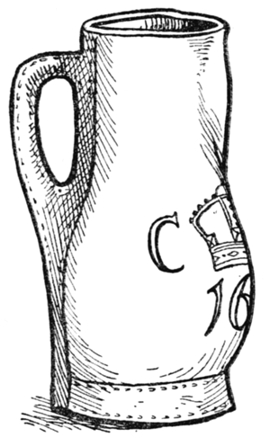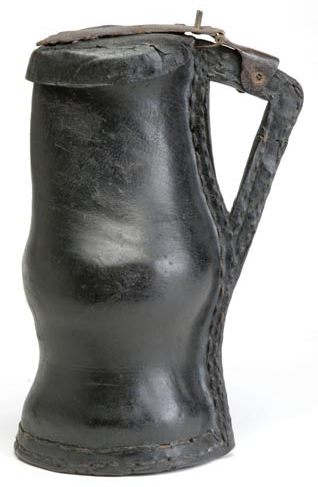
 Stein Collectors International
Stein Collectors International
Featured Stein: March 2020

 Stein Collectors International
Stein Collectors International
Featured Stein:
March 2020
The English "Black Jack"
Provided by Walt Vogdes


Left,a
sketch of a
leather Black Jack
once in the household of King Charles I of England (reigned 1625-1649
("Drinking Vessels of Bygone Days," G. J. Monson-Fitzjohn, London,
1927). While the majority of Black Jacks are unlidded, the one at right,
16th-17th century, was actually fitted with a leather lid.
The
history of leather drinking vessels stretches from ancient times to the
time of the Crimean War (1853-1856). Britain has been the home of
leather vessels for longer and in higher numbers than anywhere else in
history and their existence is quintessentially British.
The Black Jack`s name is derived from the materials used in its
construction. Leather that has been soaked in hot water and dried is
known as Jack leather. The same source can be attributed to the name
for German Jackboots and Medieval Arming Jacks. This is also the origin
of the modern word “jacket“. Jacks were originally black because the
black material used to line the inside, was used on the outside of the
vessel thus coloring it.
In the 13th Century the Guild of Cordwainers was established to
supervise the tanning and currying of leather. Specialization continued
and in the early 14th Century the Company of Botellars or bottle
makers, was established. Early ordinances of the Guild show that
leather vessel making had been officially recognized from early times,
recording in 1373 that the “mistery of botellars had been well and in order made from the time
whereof memory does not run the contrary”.
Laws were passed by various Monarchs from Edward II (1284-1327) to
Elizabeth I (1533-1603) which placed high export tariffs on leather.
This resulted in a drastic reduction in price in England and so made it
a popular choice for drinking vessels. Leather was also the material of
choice for the transportation of liquids around the country because its
light weight compared well with that of earthenware.
Responding to negative side effects of these duties, the tariffs were
revised and leather prices increased, reducing its use for drinking
vessels. It seems that such distortion of the markets is no new thing.
The history of the leather bottle, black jack and tankards continued
through various fashion changes, including the widening of the base for
stability in Tudor times, as shown by those found with the wreck of the
Mary Rose (launched 1511, sunk 1545), so we are left with a multitude
of shapes to represent the various periods.
During Elizabethan times, even wealthy merchant families would possess
just one wine glass because of the high cost of Venetian glass. Placed
in the middle of the table and used communally, it would be refilled by
a man stood in the corner with a leather bottle and known as the
botellar or, in modern terms, the butler.
Information in this article is adapted from the website for Hide Bound,
an English manufacturer of Leather Drinking Vessels
(https://www.hidebound.co.uk/page/history-of-leather-drinking-vessels/).
If you found this article interesting, you will probably also enjoy reading the following two news articles regarding a leather Black Jack purportedly made from the hide of Oliver Cromwell's horse, Blackjack:
Oliver Cromwell jug turns up on Antiques Roadshow and is worth £30,000
Antiques Roadshow’s Cromwell jug likely to be a fake, says expert